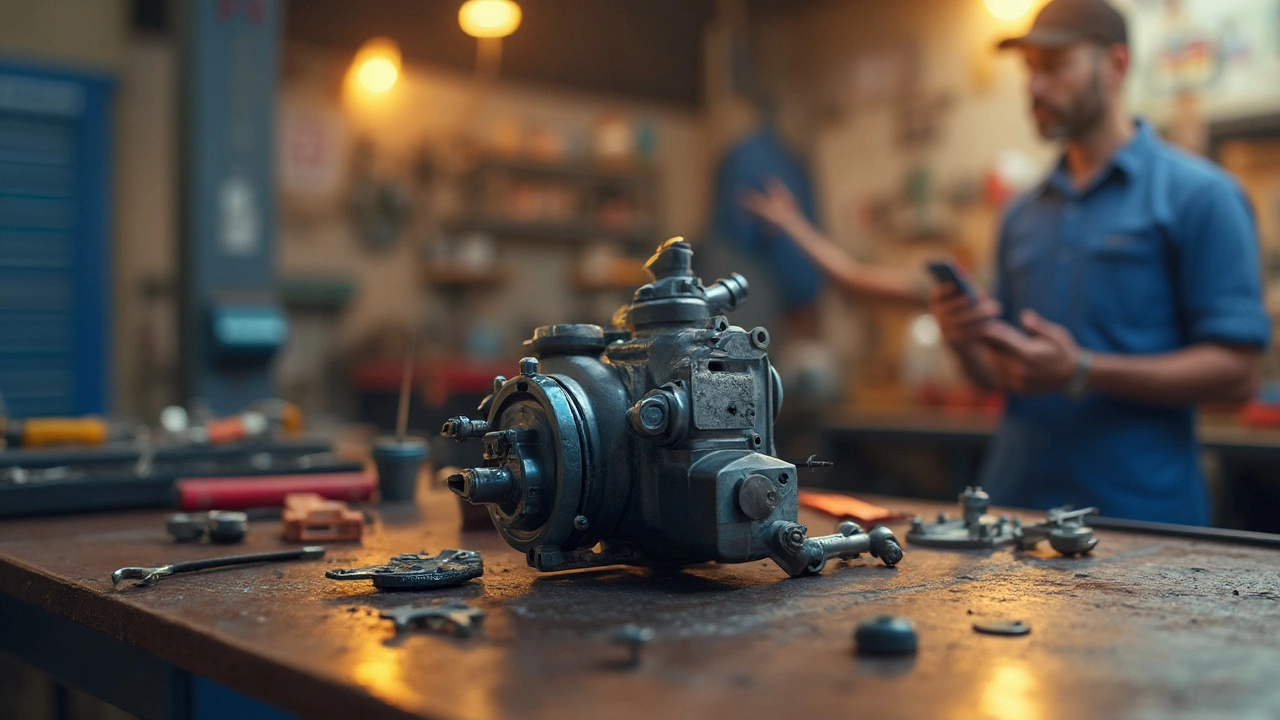How a Failing Fuel Pump Affects Car Performance: Warning Signs & Fixes
 Jul, 1 2025
Jul, 1 2025
Ever been cruising down the highway and suddenly your car coughs, sputters, and nearly dies on you? Or maybe it just refuses to start one random morning for no obvious reason. These aren’t the kind of Hollywood breakdowns where smoke is pouring out and everyone’s in a panic — real-life car trouble is sneakier. One of the most silent saboteurs hiding under your hood is a failing fuel pump. Most drivers don’t even know what that is until it starts messing with their ride. Ignore the symptoms and the result might be a wallet-thinning repair bill or your car stopping at the worst place possible.
How a Fuel Pump Works and Why It Matters
Imagine your fuel tank is a mini reservoir and the fuel pump is the hardworking delivery guy making sure your engine gets the right amount of gasoline at the right pressure. This isn’t some old-fashioned job; modern pumps are electric, sitting either inside the fuel tank or just outside it. Their whole reason for being: sending fuel from the tank to the engine through the fuel line. Remove or weaken that link, and your engine can’t get what it needs to combust fuel and make power.
Back in the day, most cars used mechanical fuel pumps, driven by the engine and working at lower pressures. Now, electric pumps can deliver fuel at 30–80 psi (pounds per square inch) or more, especially for fuel-injected engines. According to data from the U.S. Department of Energy, over 99% of vehicles built after 1990 have electric pumps designed to last well beyond 100,000 miles. That sounds impressive, but things like dirty fuel, bad gas habits, overheating, or just plain old wear and tear can make any pump give up earlier than expected.
| Type of Pump | Typical Pressure (psi) | Average Lifespan (miles) |
|---|---|---|
| Mechanical | 4-7 | 75,000–100,000 |
| Electric (older models) | 30–45 | 100,000–150,000 |
| Electric (current models) | 60–80+ | 120,000–200,000 |
Some drivers have made their pumps last longer by keeping at least a quarter tank of fuel at all times. That’s because most electric pumps rely on the gas itself for cooling. Run low on gas regularly and you risk overheating the pump, which is a fast track to pump failure.
Once the pump starts getting weak, bad things happen fast — car performance nosedives. Pump failure can leave you stranded, because your ride won’t run for more than a few seconds, if at all. So unless you like the idea of flagging down a tow truck on the side of the road, you need to know the signs.

Real Signs Your Fuel Pump Is Going Out
The first symptoms are always subtle. The car might still start, but it feels like it’s lost its old energy. Getting up to highway speed? Suddenly feels like a chore. Trying to go up a hill? The engine hesitates or judders, especially when you press harder on the gas.
Most drivers ignore these first warnings, chalking them up to "old age" or "bad gas." But here’s what really happens as a fuel pump symptoms list builds up:
- Engine Sputtering at High Speeds: One of the classic signs is the engine cutting in and out — almost like you’re running out of gas — when you’re at freeway speeds.
- Sudden Loss of Power When Under Strain: Trying to tow something, hauling a full load, or just going up a steep grade? The engine may lose muscle, even stalling.
- Engine Won’t Start or Takes Forever: You turn the key, hear the starter cranking, but the engine catches only after several tries. Or worse, it just won’t start.
- Odd Noises from the Fuel Tank: Healthy electric pumps make a gentle whir for two seconds when you turn on the key. A failing one may whine, moan, or growl.
- Frequent Engine Stalling: Your car starts, but completely shuts off unexpectedly at stoplights or in slow traffic. Sometimes it comes back to life; sometimes it doesn’t.
- Jerking Motions/Bucking: As you’re driving, your car surges forward or jerks — usually as the pump can’t keep up with demands for more fuel.
- Poor Fuel Mileage: Weak pumps might overact to failing pressure, throwing too much or too little fuel at the engine, and your gas mileage tanks as a result.
- Check Engine Light: Most cars with onboard diagnostics aren’t shy — a code like P0087 or P0230 can pop up, pointing to fuel pressure issues.
Some of these symptoms look like other problems — clogged fuel filters, ignition issues, or even stuff like bad spark plugs. But if you can rule those out, fuel pump failure climbs to the top of the suspect list, especially if two or more symptoms hit at once.
Statistics from AAA say that every year, over half a million stranded drivers call for help due to fuel system problems. A dying fuel pump is among the lead causes. It often comes without much warning, morphing mild annoyances into a total vehicle shutdown in a matter of days or weeks.

What To Do If You Suspect Fuel Pump Failure
You’re here for more than doom and gloom. So what should you do if your car’s acting up and these signs start to pile up?
First, don’t ignore the symptoms. If you catch it early, sometimes you can head off total disaster. Here’s how to move fast and smart:
- Listen Carefully: Next time you turn your key to the "ON" position (before starting the engine), listen for a low hum from the fuel tank area. If it’s silent or makes an unhealthy noise, that’s a strong clue.
- Check for Fuel Filter Issues: A clogged filter can mimic pump symptoms. If it’s cheap and easy to change (it usually is), swap it out before paying for a full pump job.
- Scan for Diagnostic Trouble Codes: Plug in an OBD-II scanner. Any codes related to fuel pressure or delivery (like P0087) means you’re on the right track.
- Test the Fuel Pressure: Mechanics use a special gauge to see if the pump’s delivering the right psi. Most auto parts stores rent these out for free with a deposit.
- Check Voltage at the Pump: With the key ON, test for battery voltage at the pump’s connector using a multimeter. No power? Could be a relay or wiring issue.
- Rule Out Other Fuel Issues: Sometimes, water in the fuel tank, a bad batch of gas, or even a failed relay or fuse can cause the same stalling or non-starting.
If your detective work points to the pump, replacing it isn’t a minor DIY project. In most cars, you have to drop the fuel tank, which is heavy and awkward. Shop labor costs can run anywhere from $400 to $1,000 or more (data from RepairPal’s 2024 survey), while just the part varies from $90 to $400 depending on if you have an economy car, pickup, or performance vehicle.
If you rely on your car for work, don’t take chances — ask a trusted shop for a quote and diagnostic first. If you’re stranded and can’t start your car at all, a towing service is usually unavoidable. Never crawl under a vehicle or mess with the tank without safe supports and zero fuel pressure in the system; gasoline is super flammable.
Here’s a smart tip: Avoid "bargain" pumps from random online sellers. Poor quality pumps often fail within a year. Stick with known brands like Bosch, Delphi, or OEM replacement parts. And don’t forget the fuel filter and maybe the relay, since old filters can clog a new pump fast.
Curious drivers sometimes ask if it’s worth using fuel system cleaners to "save" a weak pump. The answer: chances are low once the problem is advanced, but it can help maintain the pump if it’s still working fine. Just don’t expect miracles.
Lastly, simple fuel habits can extend pump life — keep your tank above a quarter full, avoid gas from sketchy places, and stick to your car’s recommended filters and service schedule.
Fuel pump failure isn’t a death sentence for your car if you catch it early. Recognize the warning signs, take quick action, and you’ll dodge the worst-case scenario. You and your car both deserve a smooth, drama-free ride.